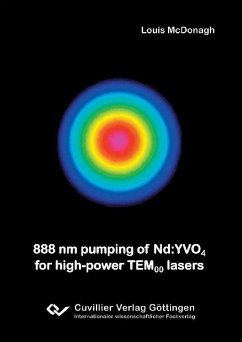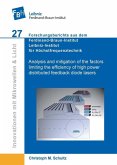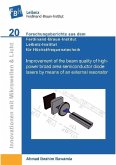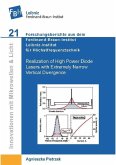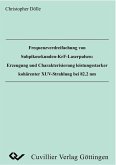For the last decade, neodymium-doped orthovanadate has established itself as the active
material of choice for commercial solid-state lasers emitting in the 1 µm range, with output powers
from several hundred milliwatts to a few tens of watts, in continuous-wave, short nanosecond
Q-switched, or picosecond modelocked pulsed regimes. Its main advantages over other Nd-doped
hosts such as YAG are a large stimulated-emission cross section leading to a high gain, a strong
pump absorption allowing the efficient mode-matching of tightly-focused pump light, and a natural
birefringence resulting in a continuously polarized output. The main drawbacks, however,
are rather poor mechanical characteristics and strong thermal lensing, effectively limiting the
maximum applicable pump power before excessively strong and aberrated thermal lensing prevents
an efficient operation in a diffraction-limited beam, and ultimately the crystal’s fracture.
Put aside the power limitation, the association of vanadate with diode end pumping allows for
the realization of highly efficient and reliable laser sources based on well-known technologies,
which provides an advantage in terms of manufacturability and cost-effectiveness over other
high-potential technologies such as disks and fibers.
This thesis introduces a novel pumping technique for Nd:YVO4 that allows for the realization
of significantly higher-power laser sources with a high optical-to-optical efficiency and
diffraction-limited beam quality, while keeping the benefits of a well-established technology. It
consists in pumping at a wavelength of 888 nm instead of the classic 808 nm, providing a low
and isotropic absorption, which results in a smooth distribution of the absorbed pump light in
long crystals, effectively limiting the deleterious effects of high inversion density such as crystal
end-facet bulging, high crystal temperature, aberrated thermal lensing, and upconversion. After
presenting vanadate’s spectroscopic and physical characteristics, a complete analysis of the heatgenerating
effects is performed, allowing for side-by-side simulations of the thermal effects in
practical 808 nm and 888 nm pumped systems, and for an evaluation of their respective thermal
lensing behaviors.
Continuous-wave operation was thoroughly investigated, first in a multi-transversal mode
oscillator to assess the maximum optical efficiency with optimum pump-mode matching and the
thermal lensing characteristics. A TEM00 resonator was then developed with a single crystal
and one pump diode, providing 60 W of output power with an optical efficiency of 55% and
a beam quality of M2 = 1.05. This resonator was symmetrically replicated to form a periodic
resonator, providing 120 W of output with the same optical efficiency and beam quality. This
two-crystal configuration was then modified to an oscillator-amplifier configuration, providing a
single-pass extraction efficiency of 53% and a total oscillator-amplifier output of 117 W without
any beam-quality degradation. Intracavity doubling of the one and two-crystal configurations
was achieved by inserting a non-critically phase-matched LiB5O3 (LBO) non-linear crystal in
the resonator, providing up to 62 W of diffraction-limited green light at 532 nm with low-noise
characteristics thanks to a large number of oscillating modes, thus limiting the effects of the
“green problem”.
A strong industrial interest resides in Q-switched lasers emitting nanosecond pulses, particularly
with a high average power, high pulse repetition rate, and pulse durations of a few
to several tens of nanoseconds. Achieving high-frequency and short-pulse operation both require
a high gain, which explains the domination of Nd:YVO4 over lower-gain materials such as
Nd:YAG or Yb:YAG. Thus, an acousto-optically Q-switched oscillator was demonstrated with
50 W output power and 28 ns pulse duration at 50 kHz. Pulse duration, however, is inversely
proportional to the pulse energy, so that an increase in repetition rate inevitably results in an
almost linear increase in pulse width. A cavity-dumped Q-switched oscillator was built to circumvent
this limitation, the pulse length being defined by the cavity roundtrip time and the
electro-optic cell switching time. It provided a constant pulse duration of 6 ns up to a repetition
rate of 100 kHz and a maximum output power of 47 W. Such short pulse durations are normally
available with output powers of a few watts from Q-switched lasers, and conversely Q-switched
lasers of similarly high output power deliver pulses of several tens to over 100 ns in duration.
There exists another strong interest in high average power quasi-cw picosecond sources,
which allow for the efficient generation of green and UV radiation, or even red-green-blue for
laser video projection. Passive mode locking with a semiconductor saturable absorber mirror
(SESAM) is the preferred technique employed for the stable and self-starting generation of
picosecond pulse trains, yet a high gain is necessary for achieving high repetition rates while
avoiding the Q-switched mode-locking regime. Thus SESAM mode locking was applied to an
888 nm pumped oscillator, achieving 57 W of output power at a repetition-rate of 110 MHz
and a pulse duration of 33 ps. Its output was efficiently amplified in a single pass up to 111 W
without any beam quality, temporal, or spectral degradation. The high peak power of 30 kW
allowed for the generation of 87 W of second harmonic at 532 nm with an efficiency of 80%, and
35 W of 355 nm third harmonic with a conversion efficiency of 33% in LBO crystals.
The wide range of high-power systems demonstrated in this work illustrate the benefits of
the optimized pumping of Nd:YVO4 at 888 nm, maintaining its highly-desirable characteristics
such as a high gain and a polarized output while extending its power capabilities far beyond
regular 808 nm pumped systems. This improvement should allow Nd:YVO4 systems to compete
with high-power technologies such as disks and fibers, which often struggle in the generation of
short pulses because of their low gain and strong non-linear effects, respectively.
Dieser Download kann aus rechtlichen Gründen nur mit Rechnungsadresse in A, B, BG, CY, CZ, D, DK, EW, E, FIN, F, GR, HR, H, IRL, I, LT, L, LR, M, NL, PL, P, R, S, SLO, SK ausgeliefert werden.

